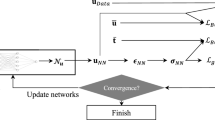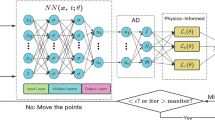Abstract
This paper gives new contributions to the development of iterative learning control for distributed parameter systems, based on using finite difference schemes to construct a finite-dimensional approximate model of the dynamics for control law design. To form a basis for the new results, systems whose dynamics are described by a fourth-order partial differential equation are considered together with the associated accuracy and numerical stability checks. Some previous control law designs use only a spatial variable as the control input, which can be a serious obstacle to practical implementation since many actuators and sensors must be deployed. This paper’s new design is based on spatially homogeneous sensing and excitation over a selected sub-area of the domain considered. Supporting numerical case studies are given to support the analysis.



















Similar content being viewed by others
References
Ahn, H. S., Chen, Y., & Moore, K. L. (2007). Iterative learning control: Brief survey and categorization. IEEE Transactions on Systems, Man and Cybernetics, Part C, 37(6), 1109–1121.
Arimoto, S., Kawamura, S., & Miyazaki, F. (1984). Bettering operations of robots by learning. Journal of Robotic Systems, 1(1), 123–140.
Augusta, P., Cichy, B., Gałkowski, K., & Rogers, E. (2015). An unconditionally stable finite difference scheme systems described by second order partial differential equations. In Proceedings of the 2015 IEEE 9th international workshop on multidimensional (nD) systems (pp. 134–139).
Bristow, D. A., Tharayil, M., & Alleyne, A. G. (2006). A survey of iterative learning control: A learning-based method for high-performance tracking control. IEEE Control Systems Magazine, 26(3), 96–114.
Cichy, B., Augusta, P., Rogers, E., Gałkowski, K., & Hurák, Z. (2008). On the control of distributed parameter systems using a multidimensional systems setting. Mechanical Systems and Signal Processing, 22, 1566–1581.
Cichy, B., Gałkowski, K., Rauh, A., Aschemann, H., Rogers, E., & Rehak, B. (2017). Modeling and iterative learning control scheme of a circular deformable) mirror. In 20th IFAC world congress (pp. 3172–3177).
Crank, J., & Nicolson, P. (1947). A practical method for numerical evaluation of solutions of partial differential equations of the heat-conduction type. Proceedings of the Cambridge Philosophical Society, 43, 50–67.
de Rozario, R., Fleming, A., & Oomen, T. (2019). Finite-time learning control using frequency response data with application to a nanopositioning stage. IEEE/ASME Transactions on Mechatronics, 24(5), 2085–2096.
Dekker, L. G., Marshall, J. A., & Larsson, J. (2019). Experiments in feedback linearized iterative learning-based path following for center-articulated industrial vehicles. Journal of Field Robotics, 36(5), 955–972.
Freeman, C. T., Rogers, E., Hughes, A.-M., Burridge, J. H., & Meadmore, K. L. (2012). Iterative learning control in healthcare electrical stimulation and robotic-assisted upper limb stroke rehabilitation. IEEE Control Systems Magazine, 32(1), 18–43.
Hładowski, L., Gałkowski, K., Cai, Z., Rogers, E., Freeman, C. T., & Lewin, P. L. (2010). Experimentally supported 2D systems based iterative learning control law design for error convergence and performance. Control Engineering Practice, 18(4), 339–348.
Huang, D., Li, X., Xu, J.-X., Xu, C., & He, W. (2014). Iterative learning control of inhomogeneous distributed parameter systems-frequency domain design and analysis. Systems & Control Letters, 72, 22–29.
Ketelhut, M., Stemmler, S., Gesenhues, J., Hein, M., & Abel, D. (2019). Iterative learning control of ventricular assist devices with variable cycle durations. Control Engineering Practice, 83, 33–44.
Lim, I., Hoelzle, D. J., & Barton, K. L. (2017). A multi-objective iterative learning control approach for additive manufacturing applications. Control Engineering Practice, 64, 74–87.
Paszke, W., Rogers, E., & Galkowski, K. (2016). Experimentally verified generalized KYP lemma based iterative learning control design. Control Engineering Practice, 53, 57–67.
Rabenstein, R., & Steffen, P. (2009). Implicit discretization of linear partial differential equations and repetitive processes. In Proceedings of the 6th international workshop on multidimensional (nD) systems
Rabenstein, R., & Steffen, P. (2011). Stability analysis for implicit second order finite difference schemes. In Proceedings of 7th international workshop on multidimensional (nD) systems (nDs).
Rabenstein, R., & Steffen, P. (2012). Numerical iterative methods and repetitive processes. Multidimensional Systems and Signal Processing, 23(1–2), 163–183.
Rafajlowicz, W., Jurewicz, P., Reiner, J., & Rafajlowicz, E. (2019). Iterative learning of optimal control for nonlinear processes with applications to laser additive manufacturing. IEEE Transactions on Control Systems Technology, 27(6), 2647–2654.
Rogers, E., Gałkowski, K., & Owens, D. H. (2007). Control systems theory and applications for linear repetitive processes. In Lecture notes in control and information sciences (Vol. 349). Springer.
Smith, G. D. (1985). Numerical solution of partial differential equations. Finite difference methods. Oxford: Oxford University Press.
Strikwerda, J. C. (1989). Finite difference schemes and partial differential equations. Belmont: Wadsworth and Brooks.
Timoshenko, S., & Woinowski-Krieger, S. (1959). Theory of plates and shells. New York: McGraw Hill.
Funding
The work was partially supported by the National Science Centre in Poland, grant no. 2020/37/B/ST7/03280.
Author information
Authors and Affiliations
Corresponding author
Additional information
Publisher's Note
Springer Nature remains neutral with regard to jurisdictional claims in published maps and institutional affiliations.
Appendix A Notation
Appendix A Notation
Rights and permissions
About this article
Cite this article
Cichy, B., Augusta, P., Galkowski, K. et al. Modeling and iterative learning control of spatially distributed parameter systems with sensing and actuation over a selected area of the domain. Multidim Syst Sign Process 32, 1237–1258 (2021). https://doi.org/10.1007/s11045-021-00780-1
Received:
Revised:
Accepted:
Published:
Issue Date:
DOI: https://doi.org/10.1007/s11045-021-00780-1




